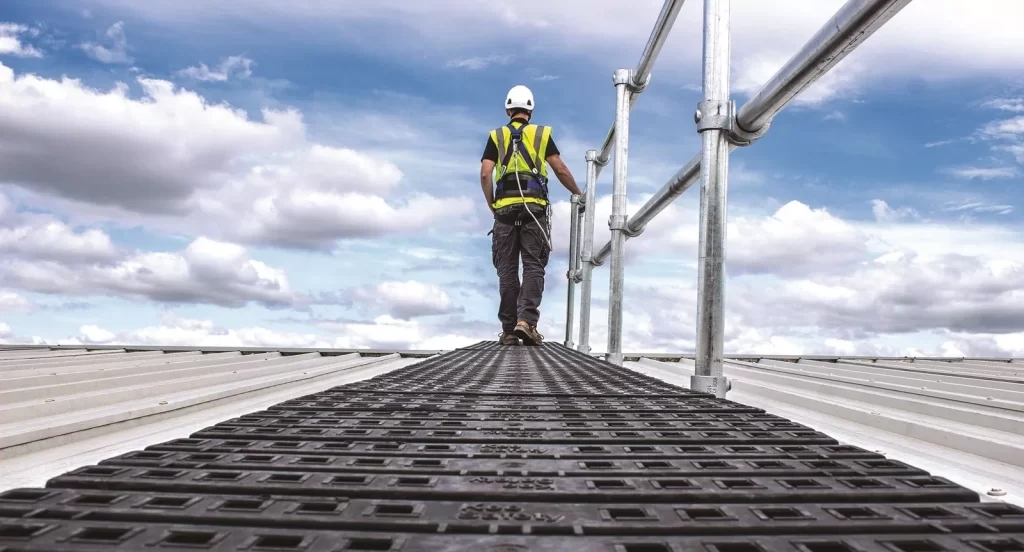Rooftop Safety – Best Practices for Working at Heights

Workers on rooftops should always wear safety harnesses, using ladders that meet OSHA standards and employing ladder defenders as protection.
Guardrails and barriers may be placed around rooftop openings or unprotected edges to physically safeguard workers. Personal fall protection devices like lanyards are also utilized as physical precautions.
1. Identify the Roof’s Hazards
Falls from elevated working positions are one of the primary rooftop hazards and can result in serious injuries. Before beginning any project, team leaders must conduct a formal risk analysis to identify all possible fall hazards that could threaten worker safety – these may include power lines, ladders with missing rungs or unstable structures; loose roof shingles; loose roofing materials which might trip someone.
Rooftop hazard avoidance strategies can include employing guardrails, barriers and personal fall protection systems correctly to effectively mitigate the risk of accidents and lessen injuries sustained on rooftops. When used appropriately, these tools can significantly lessen risks while helping avoid serious incidents from occurring.
Other risks on rooftops may include poor line of sight due to obstruction from ridge vents, chimneys or shingle bundles that block access points. Workers should maintain clear lines of sight so they know their position relative to the edge of the roof.
2. Prevent Tripping
No matter where they work – maintenance, roof work or anywhere else elevated – workers can easily slip or trip while on an elevated surface and fall from height, leading to serious injuries and even fatalities.
For this type of accident to be prevented, it’s crucial that all walkways and work areas are free from potential hazards. Once this has been achieved, identify safe walking routes for pedestrians to follow and encourage them to follow these paths.
On a hot day, adequate ventilation is also key as prolonged heat exposure can lead to dehydration resulting in confusion, headaches, dizziness and fatigue as a result of dehydration.
An essential addition to any facility with employees who regularly or intermittently perform rooftop tasks, safety rail systems are an integral component. Portable guardrail systems can provide short-term projects while permanent installations offer long-term protection and peace of mind whenever workers require it. Regular inspection of these systems must take place.
3. Keep the Roof Clean
Working at height poses obvious safety hazards, yet even non-construction workers who frequent roofs or other elevated surfaces must abide by certain best practices to safeguard themselves – this includes conducting regular fall protection risk assessments to identify any potential dangers and identify measures to address them.
Clean roofs help protect structures from pest damage caused by pests that find shelter among moss and debris, adding curb appeal and increasing its resale value.
Before employees ascend a roof to scrub away grime and pests, they should ensure they have all of the appropriate equipment for their job. This should include a ladder tall enough to reach it safely, rubber-soled shoes, a garden hose for rinsing purposes and a bucket to mix cleaning solution. Furthermore, it is wise not to use high water pressure; doing so can damage shingles while loosening protective granules from them; instead opt for soft washing techniques which are safe for all roofing materials.
4. Train Your Team
Working at height can be extremely hazardous work, even with appropriate risk assessments in place and protective equipment in use. To reduce this danger, ensure your team receives proper training prior to starting any tasks at height.
Training should focus on how to use and maintain personal protective equipment (PPE), including emergency procedures. Training should take place every six months in order to stay abreast of current safety guidelines.
Working at height may be essential to certain jobs such as window washing and roofers; however, it needn’t be dangerous. By following the nine essential safety tips detailed herein, your team can avoid workplace hazards and keep themselves safe. For more information about training your team safely and effectively to work at height, get in touch with us to find out about our IOSH approved working at height training course.



